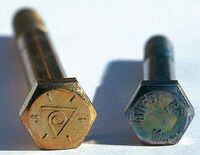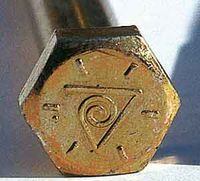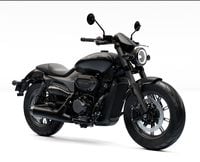Many, but not all bolts, are stamped with either a number (metric bolts) or a series of lines (fractional or "American" bolts) indicating their minimum strength or, more technically, their property class. Besides, the head markings' most reputable manufacturers also stamp their trademark in the bolt head so that it is readily identifiable and traceable. Why aren't all bolts stamped? The laws regarding the manufacture of hardware are pretty vague, and there are lots of ways to get around them. For example, hardware manufactured to OEM specification isn't required to be marked. That's why there are no indicators stamped into the head of your swingarm bolt. In another example, if a hardware manufacturer claims his high-zoot chrome-plated stuff meets or exceeds a particular OEM standard and says so in writing, he doesn't need to actually stamp the head of a bolt.
So why should you care what's stamped on the head of a bolt? Two reasons; first if you need to replace a bolt you certainly don't want to substitute one that's weaker than the one you're replacing. Second, if you know the property class of a bolt and its diameter, you can determine the suggested basic torque setting, even if you don't have a shop manual handy. Most industrial supply stores or specialty hardware suppliers will gladly provide a chart that lists torque settings based on property class, thread pitch and diameter for a wide range of bolts. For instance, 8mm bolts with a 1.25 thread pitch are normally available in property class ranges from 8.8 to 12.9. The higher the number, the stronger the bolt. Depending on their property class, 8mm bolts can be safely torqued from 19 foot-pounds to 37 foot-pounds. Torque an 8.8 bolt to 37 foot-pounds though, and you'll end up with two halves of a bolt -- or one that's so overstressed it may as well be broken.
By the same token, replacing a bolt marked 12.9 with an 8.8 bolt is a recipe for disaster. The softer 8.8 bolt just isn't strong enough to cope with the loads born by the 12.9. Going the other way, replacing a low grade bolt with a stronger one is generally acceptable although there are times when a soft bolt is used to cope with certain types of loads that would shear a harder one.
Now that you have a basic understanding of bolt-head markings there is no excuse for installing the wrong bolt just "because it fits." If the bolt you'd like to replace isn't marked, or you can't find one identical to it, you'll need a service or parts manual to determine the grade. But if you do know the property class, replacement is only as far away as your nearest hardware store.
For more articles on how to maintain and modify your motorcycle, see the Tech section of MotorcycleCruiser.com.


/cloudfront-us-east-1.images.arcpublishing.com/octane/OQVCJOABCFC5NBEF2KIGRCV3XA.jpg)
/cloudfront-us-east-1.images.arcpublishing.com/octane/F3O2DGLA4ZBDJGNVV6T2IUTWK4.jpg)
/cloudfront-us-east-1.images.arcpublishing.com/octane/ZXYQE3MHLFDSPKNGWL7ER5WJ4U.jpg)
/cloudfront-us-east-1.images.arcpublishing.com/octane/RDF24VM7WVCOBPIR3V3R4KS63U.jpg)
/cloudfront-us-east-1.images.arcpublishing.com/octane/W7RSIBFISNHJLIJESSWTEBTZRQ.jpg)
/cloudfront-us-east-1.images.arcpublishing.com/octane/AERA26ENRNBW3K324YWCPEXYKM.jpg)
/cloudfront-us-east-1.images.arcpublishing.com/octane/YWX3YX7QBBHFXFDMEEEKRG4XJE.jpg)
/cloudfront-us-east-1.images.arcpublishing.com/octane/I7OKI53SZNDOBD2QPXV5VW4AR4.jpg)
/cloudfront-us-east-1.images.arcpublishing.com/octane/IH52EK3ZYZEDRD3HI3QAYOQOQY.jpg)
/cloudfront-us-east-1.images.arcpublishing.com/octane/K2FSAN7OWNAXRJBY32DMVINA44.jpg)
/cloudfront-us-east-1.images.arcpublishing.com/octane/G4XK7JL24FCUTKLZWUFVXOSOGE.jpg)
/cloudfront-us-east-1.images.arcpublishing.com/octane/JJNXVAC27ZCDDCMTHTQZTHO55Y.jpg)










/cloudfront-us-east-1.images.arcpublishing.com/octane/3VSTLPKOHNFTRJTIAAXDPGCPA4.jpg)
